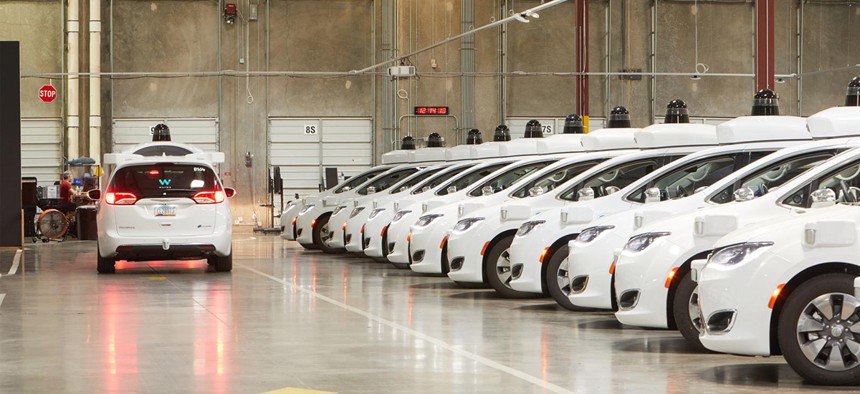The Future of Transport is Massive Warehouses Filled With Robot Minivans

Waymo/Quartz
This is Waymo’s vision of the future.
Time to go to work. Pick up your phone; there’s a notification that a Waymo van is en route to pick you up and then drop you off at the repair facility. Pull on your work clothes, tell Google Assistant you’re leaving for the day, and walk out to the car. The door sides open automatically. You nod at your four silent coworkers already sitting inside, who all return to staring at their phones when the door slides shut. There’s no one at the wheel; the van drives itself. It’s still pre-dawn, so there’s not much to see out the window as you leave the Downtown Pedestrian Zone and head to the warehouse. Your ride pops into one of the receiving bays, and a weary group of workers from the graveyard shift take your spots in the van. Your eyes adjust to the fluorescent lights. Your shift ends after dark and you realize you won’t see the sun today.
In the not-too-distant future, hailing a ride from a self-driving vehicle could be as easy as calling an Uber or Lyft is today, and people working on those vehicles will likely be as numerous as the robots themselves.
In a blog post Tuesday, Waymo showed off the parts of its burgeoning business that perhaps might not seem as exciting as its robot cars, but are nonetheless massively important for turning its concept into a viable operation. The post outlines the new roles that mechanics, dispatchers, and customer-service workers are taking on as the company expands from a few small tests around the U.S. to a full autonomous ride-hailing service in the Phoenix, Arizona metropolitan area.

Behind the cutting-edge technology is a staff of human workers, milling about prepping and fixing the cars. (At least, until those jobs are automated, too.)
In Waymo’s vision of the future, being able to hail its cars at a moments’ notice could completely upend our relationship with cars and urban areas.—The self-driving cars would constantly be on the move, and so wouldn’t plug up parking spots around town. Personal car ownership could one day be a thing of the past.

But the vehicles will still require a large physical space for their storage and repair. Even a few dozen cars fill a big warehouse, and it’s entirely feasible to envision a future where Waymo, or another company working on autonomous vehicles, has succeeded in rolling out a safe, effective self-driving-car service nationwide—that turns our suburbs into wastelands dominated by nondescript depot centers for our robot taxis.
While many have decried the rise of automation as an existential threat to the global workforce, it does appear that Waymo needs a lot of people to run its operations. People who may have once worked out in the world as drivers or mechanics might end up housed in large, windowless boxes. At least they’ll have jobs, though.





